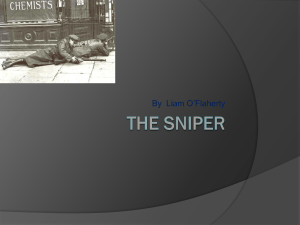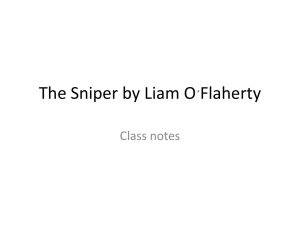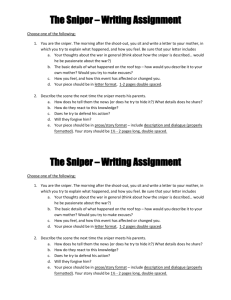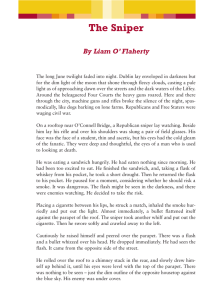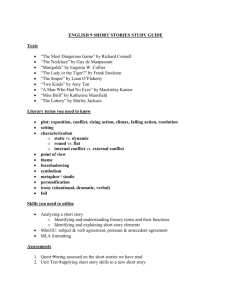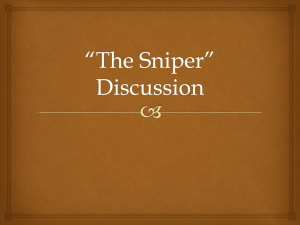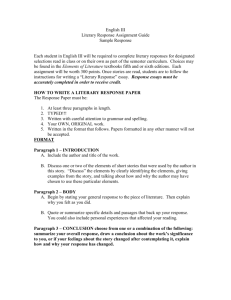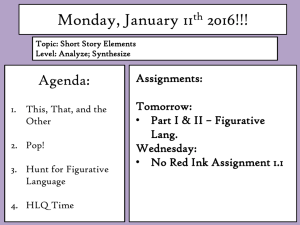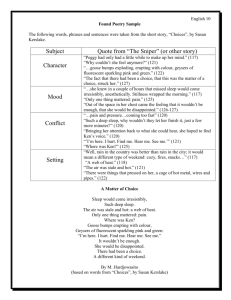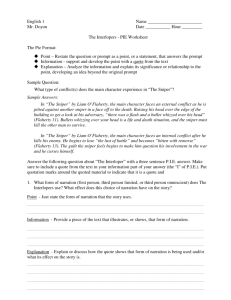Historical Background for “The Sniper” by Liam O’Flaherty
advertisement
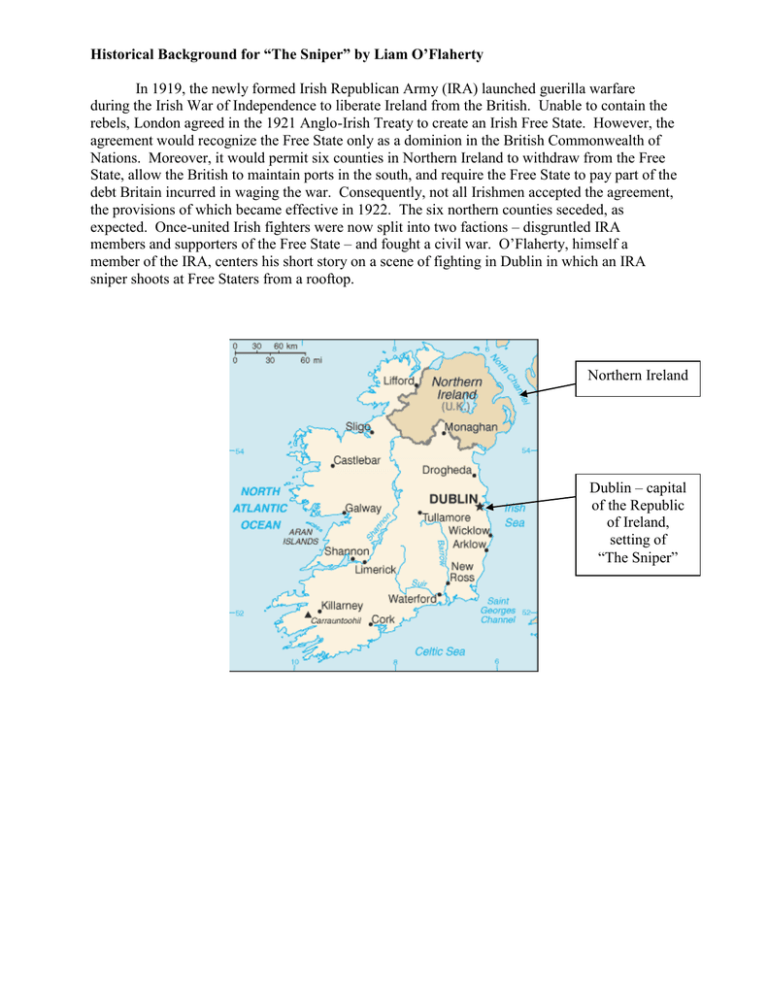
Historical Background for “The Sniper” by Liam O’Flaherty In 1919, the newly formed Irish Republican Army (IRA) launched guerilla warfare during the Irish War of Independence to liberate Ireland from the British. Unable to contain the rebels, London agreed in the 1921 Anglo-Irish Treaty to create an Irish Free State. However, the agreement would recognize the Free State only as a dominion in the British Commonwealth of Nations. Moreover, it would permit six counties in Northern Ireland to withdraw from the Free State, allow the British to maintain ports in the south, and require the Free State to pay part of the debt Britain incurred in waging the war. Consequently, not all Irishmen accepted the agreement, the provisions of which became effective in 1922. The six northern counties seceded, as expected. Once-united Irish fighters were now split into two factions – disgruntled IRA members and supporters of the Free State – and fought a civil war. O’Flaherty, himself a member of the IRA, centers his short story on a scene of fighting in Dublin in which an IRA sniper shoots at Free Staters from a rooftop. Northern Ireland Dublin – capital of the Republic of Ireland, setting of “The Sniper” “The Sniper” by Liam O’Flaherty The long June twilight faded into night. Dublin lay enveloped in darkness but for the dim light of the moon that shone through fleecy clouds, casting a pale light as of approaching dawn over the streets and the dark waters of the Liffey. Around the beleaguered Four Courts the heavy guns roared. Here and there through the city, machine guns and rifles broke the silence of the night, spasmodically, like dogs barking on lone farms. Republicans and Free Staters were waging civil war. On a rooftop near O'Connell Bridge, a Republican sniper lay watching. Beside him lay his rifle and over his shoulders was slung a pair of field glasses. His face was the face of a student, thin and ascetic, but his eyes had the cold gleam of the fanatic. They were deep and thoughtful, the eyes of a man who is used to looking at death. He was eating a sandwich hungrily. He had eaten nothing since morning. He had been too excited to eat. He finished the sandwich, and, taking a flask of whiskey from his pocket, he took a short drought. Then he returned the flask to his pocket. He paused for a moment, considering whether he should risk a smoke. It was dangerous. The flash might be seen in the darkness, and there were enemies watching. He decided to take the risk. Placing a cigarette between his lips, he struck a match, inhaled the smoke hurriedly and put out the light. Almost immediately, a bullet flattened itself against the parapet of the roof. The sniper took another whiff and put out the cigarette. Then he swore softly and crawled away to the left. Cautiously he raised himself and peered over the parapet. There was a flash and a bullet whizzed over his head. He dropped immediately. He had seen the flash. It came from the opposite side of the street. He rolled over the roof to a chimney stack in the rear, and slowly drew himself up behind it, until his eyes were level with the top of the parapet. There was nothing to be seen-just the dim outline of the opposite housetop against the blue sky. His enemy was under cover. Just then an armored car came across the bridge and advanced slowly up the street. It stopped on the opposite side of the street, fifty yards ahead. The sniper could hear the dull panting of the motor. His heart beat faster. It was an enemy car. He wanted to fire, but he knew it was useless. His bullets would never pierce the steel that covered the gray monster. Then round the corner of a side street came an old woman, her head covered by a tattered shawl. She began to talk to the man in the turret of the car. She was pointing to the roof where the sniper lay. An informer. The turret opened. A man's head and shoulders appeared, looking toward the sniper. The sniper raised his rifle and fired. The head fell heavily on the turret wall. The woman darted toward the side street. The sniper fired again. The woman whirled round and fell with a shriek into the gutter. Suddenly from the opposite roof a shot rang out and the sniper dropped his rifle with a curse. The rifle clattered to the roof. The sniper thought the noise would wake the dead. He stooped to pick the rifle up. He couldn't lift it. His forearm was dead. "I'm hit," he muttered. Dropping flat onto the roof, he crawled back to the parapet. With his left hand he felt the injured right forearm. The blood was oozing through the sleeve of his coat. There was no pain--just a deadened sensation, as if the arm had been cut off. Quickly he drew his knife from his pocket, opened it on the breastwork of the parapet, and ripped open the sleeve. There was a small hole where the bullet had entered. On the other side there was no hole. The bullet had lodged in the bone. It must have fractured it. He bent the arm below the wound. the arm bent back easily. He ground his teeth to overcome the pain. Then taking out his field dressing, he ripped open the packet with his knife. He broke the neck of the iodine bottle and let the bitter fluid drip into the wound. A paroxysm of pain swept through him. He placed the cotton wadding over the wound and wrapped the dressing over it. He tied the ends with his teeth. Then he lay still against the parapet, and, closing his eyes, he made an effort of will to overcome the pain. In the street beneath all was still. The armored car had retired speedily over the bridge, with the machine gunner's head hanging lifeless over the turret. The woman's corpse lay still in the gutter. continued… The sniper lay still for a long time nursing his wounded arm and planning escape. Morning must not find him wounded on the roof. The enemy on the opposite roof coverd his escape. He must kill that enemy and he could not use his rifle. He had only a revolver to do it. Then he thought of a plan. Taking off his cap, he placed it over the muzzle of his rifle. Then he pushed the rifle slowly upward over the parapet, until the cap was visible from the opposite side of the street. Almost immediately there was a report, and a bullet pierced the center of the cap. The sniper slanted the rifle forward. The cap clipped down into the street. Then catching the rifle in the middle, the sniper dropped his left hand over the roof and let it hang, lifelessly. After a few moments he let the rifle drop to the street. Then he sank to the roof, dragging his hand with him. Crawling quickly to his feet, he peered up at the corner of the roof. His ruse had succeeded. The other sniper, seeing the cap and rifle fall, thought that he had killed his man. He was now standing before a row of chimney pots, looking across, with his head clearly silhouetted against the western sky. The Republican sniper smiled and lifted his revolver above the edge of the parapet. The distance was about fifty yards--a hard shot in the dim light, and his right arm was paining him like a thousand devils. He took a steady aim. His hand trembled with eagerness. Pressing his lips together, he took a deep breath through his nostrils and fired. He was almost deafened with the report and his arm shook with the recoil. Then when the smoke cleared, he peered across and uttered a cry of joy. His enemy had been hit. He was reeling over the parapet in his death agony. He struggled to keep his feet, but he was slowly falling forward as if in a dream. The rifle fell from his grasp, hit the parapet, fell over, bounded off the pole of a barber's shop beneath and then clattered on the pavement. Then the dying man on the roof crumpled up and fell forward. The body turned over and over in space and hit the ground with a dull thud. Then it lay still. The sniper looked at his enemy falling and he shuddered. The lust of battle died in him. He became bitten by remorse. The sweat stood out in beads on his forehead. Weakened by his wound and the long summer day of fasting and watching on the roof, he revolted from the sight of the shattered mass of his dead enemy. His teeth chattered, he began to gibber to himself, cursing the war, cursing himself, cursing everybody. He looked at the smoking revolver in his hand, and with an oath he hurled it to the roof at his feet. The revolver went off with a concussion and the bullet whizzed past the sniper's head. He was frightened back to his senses by the shock. His nerves steadied. The cloud of fear scattered from his mind and he laughed. Taking the whiskey flask from his pocket, he emptied it a drought. He felt reckless under the influence of the spirit. He decided to leave the roof now and look for his company commander, to report. Everywhere around was quiet. There was not much danger in going through the streets. He picked up his revolver and put it in his pocket. Then he crawled down through the skylight to the house underneath. When the sniper reached the laneway on the street level, he felt a sudden curiosity as to the identity of the enemy sniper whom he had killed. He decided that he was a good shot, whoever he was. He wondered did he know him. Perhaps he had been in his own company before the split in the army. He decided to risk going over to have a look at him. He peered around the corner into O'Connell Street. In the upper part of the street there was heavy firing, but around here all was quiet. The sniper darted across the street. A machine gun tore up the ground around him with a hail of bullets, but he escaped. He threw himself face downward beside the corpse. The machine gun stopped. Then the sniper turned over the dead body and looked into his brother's face. “The Sniper” Comprehension Questions 1. Using a dictionary, define the following words that appear in the story “The Sniper”: - beleaguered - spasmodically - ascetic - parapet - turret - paroxysm - ruse 2. What is the plot of the story? Create a plot graph in your notes using examples from the story to support your response. 3. What is the mood of the story? (note: the mood can change as the story progresses) 4. Who is the enemy sniper whom the protagonist kills? 5. Who is the antagonist? 6. What types of conflict appear in the story “The Sniper”? List as many conflicts as you can find with examples from the story to support your response. 7. What is the theme of “The Sniper”? 8. What is the setting of the story? 9. Provide examples from “The Sniper” which show suspense. 10. What is the point of view of “The Sniper”? Four Courts along the Liffey River Four Courts
